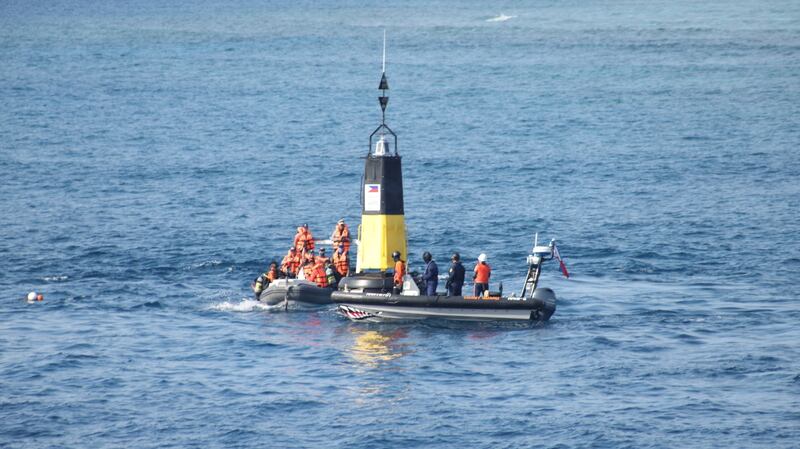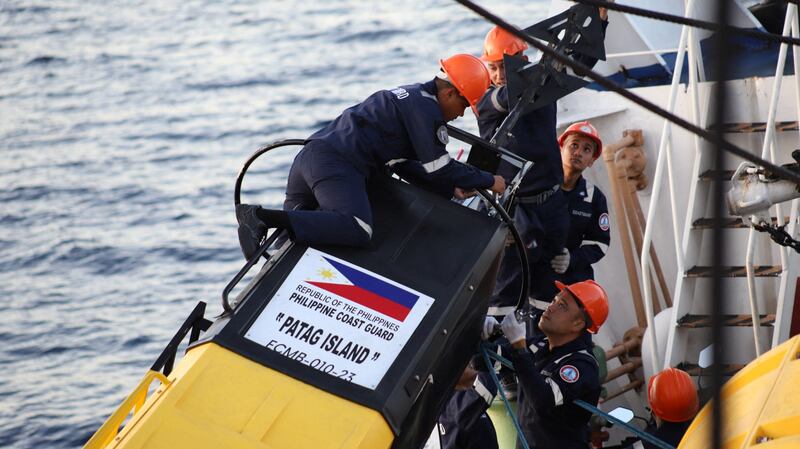Earlier this month, the Philippine Coast Guard deployed five 30-foot navigational buoys near islands and reefs within its territory in the South China Sea, saying the move highlighted the nation’s “unwavering resolve to protect its maritime borders.”
Within two weeks, China had deployed three buoys of its own, positioning two near Manila’s beacons at Irving Reef and Whitsun Reef, to ensure “safety of navigation.”
The tit-for-tat deployments signaled a new front in a long-running dispute over sovereignty of the Spratly Islands in the South China Sea, one of the world’s most important sea trade routes that is considered a flashpoint for conflict in the Asia-Pacific.
But the buoys also underscored an increasingly proactive approach by the Philippines in enforcing its maritime rights, analysts say.
“Such a move illustrates Manila’s awareness of the changing nature of regional geopolitics,” said Don McLain Gill, a Manila-based geopolitical analyst and lecturer at De La Salle University.
“The Philippines also recognizes that no other external entity can effectively endorse its legitimate interests other than itself.”

China claims nearly all of the South China Sea and has for years militarized artificial islands, while deploying coast guard boats and a state-backed armed fishing fleet around disputed areas.
In 2016, an international tribunal ruled in favor of Manila and against Beijing’s expansive historical claims to the region, but China has since refused to acknowledge the ruling.
The Philippines, Malaysia, Brunei, Vietnam and Taiwan all have claims in the sea – and Manila’s buoy deployment prompted an official protest from Hanoi.
Since taking office in June last year, Philippines President Ferdinand Marcos Jr. has been more vocal in condemning China's aggressive actions in the region and has restored traditional military ties with the United States.
Raymond Powell, the South China Sea lead at Stanford University’s Gordian Knot Center for National Security Innovation, said the recent deployment of buoys showed the Philippines’ newfound determination to “proactively assert its maritime interests.”
‘A war of buoys’
While Marcos Jr. was praised by some for the deployment, others have criticized the move as needlessly provocative.
Filipino security analyst Rommel Banlaoi said the unilateral action heightened security tensions and could have “unintended negative consequences.”
“What the Philippines did was problematic because the international community recognizes the South China Sea as disputed waters,” said Banlaoi, who chairs the advisory board of the China Studies Center at New Era University’s School of International Relations.
“This might trigger a war of buoys,” he said in an interview last week with local radio station DZBB.
The Philippines National Security Adviser Eduardo Año said the deployment of buoys was meant to enforce the 2016 arbitral ruling in the Hague.
“This is not a provocation. What we call provocations are those who conduct dangerous maneuvering, laser pointing, blocking our vessels, harassing our fishermen,” he told reporters in an interview, referring to recent Chinese actions in the South China Sea.
Jay Batongbacal, director of the University of the Philippines Institute for Maritime Affairs and Law of the Sea, said the installation of the buoys demonstrated the Philippines was exercising jurisdiction over its waters for purposes of improving navigational safety.
“Such buoys are harmless devices that warn all other ships of potential hazards and should in no way be regarded as provocative or threatening,” Batongbacal told BenarNews.
He asked why critics were silent about China building artificial islands, installing anti-air and anti-ship missiles, and deploying missile boats and large coast guard vessels that actively interfere with Philippine boats in its maritime territory.
Angering Vietnam
Not only did the buoy deployment set off another round of recriminations between Beijing and Manila, it also drew a rebuke from Vietnam, which claims parts of the Spratly Islands as its own.
When asked about Manila’s action, Vietnamese Foreign Ministry spokeswoman Pham Thu Hang said Hanoi “strongly opposes all acts violating Vietnam’s sovereign rights.”
Analysts say, however, the spat is unlikely to escalate, as Vietnam has far bigger issues to deal with in terms of China’s incursions into its territorial waters.
A Chinese survey ship, escorted by China Coast Guard and maritime militia, was found lingering within Vietnam's exclusive economic zone for several days from May 7, often within fifty nautical miles of its southern coast.

Powell said the incursions were “much more provocative than the Philippines’ buoys.”
“I think Vietnam’s pro-forma protest over the latter will be noted and largely forgotten, both in Hanoi and in Manila,” Powell told BenarNews.
Vietnam’s reaction to the Philippines’ move was natural “due to its potential political ramifications at the domestic level,” said Gill. But he added that Southeast Asian nations had a track record of settling maritime disputes in an amicable manner.
In 2014, for example, the Philippines and Indonesia settled a maritime border dispute after two decades of negotiations by using international law, particularly the United Nations Convention on the Law of the Sea.
“Unlike China, Southeast Asian countries have illustrated a rather positive track record of being able to compromise and solve bilateral tensions between and among each other given the countries’ collective desire to maintain stability in the region,” Gill said.
